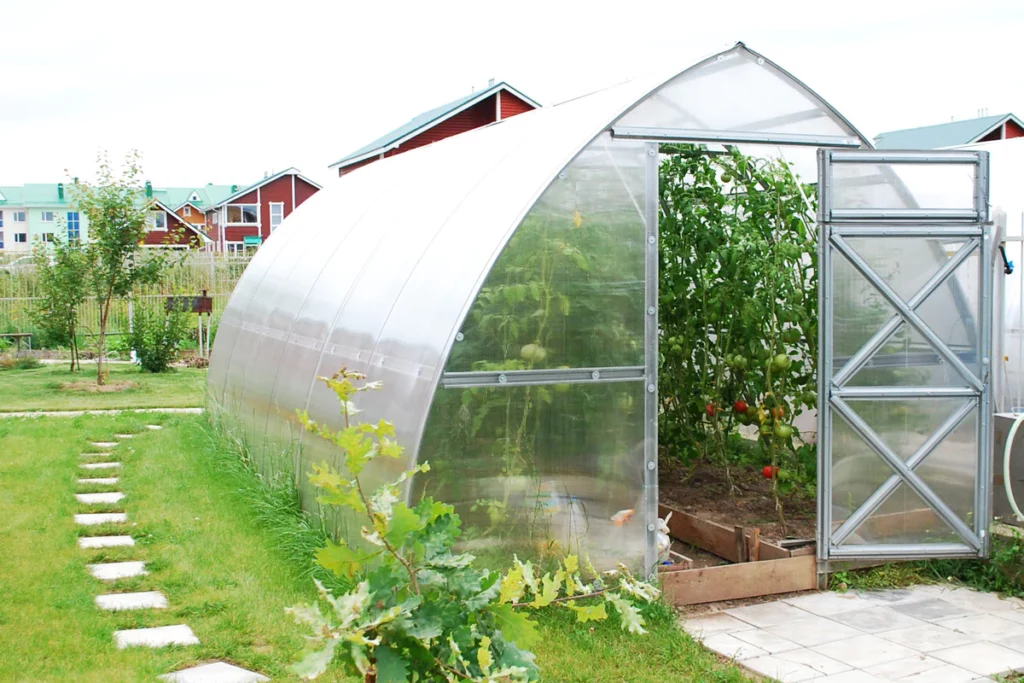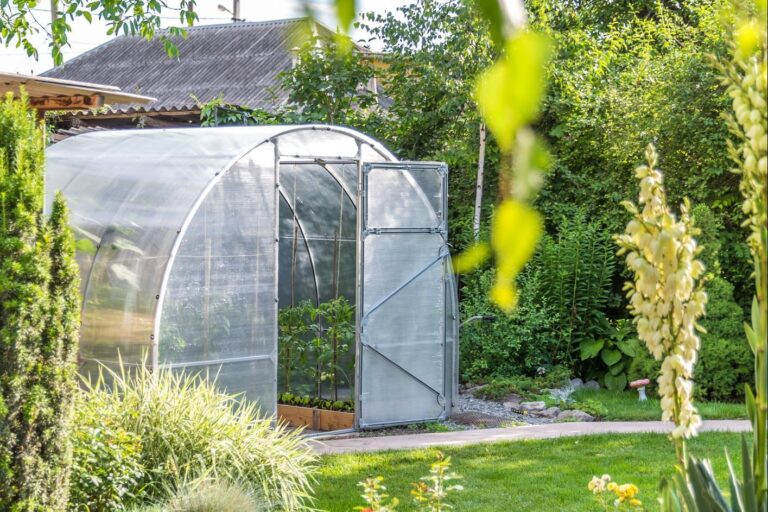One sunny morning, I found myself in my garden, with colorful flowers all around and leaves swaying gently in the breeze. While I enjoyed this peaceful scene, a thought crossed my mind: Should you keep the greenhouse door open?
This question about whether to keep the greenhouse door open or closed has puzzled gardeners for a long time. Some folks think that fresh air is a must, while others believe sealing it up is safer. I was right in the middle of this old puzzle.
In this article, let’s embark on a journey through the fascinating world of greenhouses, where I’ll help you explore the ins and outs of a question that’s been around for ages: Should you leave the greenhouse door open?
Whether to leave a greenhouse door open or closed depends on factors like temperature, ventilation, humidity, and plant types. Open it to dissipate heat, improve airflow, and reduce humidity, but be cautious about pests and adverse weather. Monitor conditions and adjust accordingly for optimal plant health. Automation systems can help with control.
What Is the Impact of Ventilation on Greenhouses?

Exploring the crucial role of ventilation in greenhouses and its profound impact on plant health and growth.
Importance of airflow for plant health:
Oxygen Exchange: Proper ventilation ensures that plants receive an adequate supply of oxygen. In photosynthesis, plants convert carbon dioxide into oxygen and glucose, and they need a continuous flow of fresh air for this process.
Carbon Dioxide Removal: In addition, ventilation helps remove excess carbon dioxide, which can accumulate in the greenhouse, especially when plants are in the growth phase. Elevated carbon dioxide levels can hinder plant growth.
Controlling temperature and humidity:
Temperature Regulation: Ventilation allows you to control the temperature inside the greenhouse. During hot weather, it helps prevent overheating by expelling excess heat. In cold weather, it can help maintain a stable temperature by preventing heat loss.
Humidity Management: Proper airflow helps maintain the right humidity levels. High humidity can lead to mold growth, while low humidity can cause plant stress. Ventilation helps strike a balance.
Preventing mold and diseases:
Reducing Condensation: Ventilation minimizes condensation on greenhouse surfaces. Condensation can create a moist environment conducive to mold and disease development.
Disease Control: Air circulation prevents stagnant, moist conditions that favor the spread of diseases. It also helps with the quick drying of plant foliage after watering, reducing the risk of fungal infections.
What Are the Essential Factors to Consider?
Delving into the key factors that demand your attention when managing a successful greenhouse operation.
External weather conditions:
Hot and sunny days:
During hot and sunny days, it’s crucial to provide adequate ventilation to prevent overheating. This may involve opening doors, vents, and windows to allow cool air to enter and hot air to escape.
Furthermore, shade cloth or netting can be used to reduce the intensity of sunlight and heat inside the greenhouse.
Cold and windy days:
In cold and windy conditions, maintaining temperature is paramount. Greenhouses may need to be well-sealed to prevent drafts and heat loss. Moreover, use insulation or double-glazing to retain heat and protect plants from frost.
Types of plants in the greenhouse:
Different plants have varying ventilation requirements. For example, tropical plants might need more humidity, while cacti prefer drier conditions. Understanding the specific needs of your plants is essential for effective ventilation.
Greenhouse design and size:
The design and size of your greenhouse play a significant role in ventilation. Larger greenhouses may require multiple ventilation points to ensure even airflow. Consider the orientation of the greenhouse concerning prevailing winds and sunlight to optimize natural ventilation.
In addition, utilize tools such as exhaust fans, louvers, and roof vents to enhance ventilation in larger or more complex greenhouse structures.
What Are The Benefits of Leaving the Greenhouse Door Open?
Unveiling the surprising advantages of embracing open doors in your greenhouse for improved plant well-being and productivity.
Enhanced air circulation:
Opening the greenhouse door allows for improved air circulation. As fresh air enters and circulates, it reaches all areas of the greenhouse, ensuring that all plants receive an adequate supply of carbon dioxide and oxygen.
Moreover, enhanced air circulation can also help distribute heat more evenly, reducing temperature variations within the greenhouse.
Temperature regulation:
Leaving the greenhouse door open can help regulate temperatures. During the daytime, when it’s sunny and warm, open doors allow excess heat to escape, preventing overheating.
At night, especially in colder seasons, leaving the door open might help maintain a stable temperature by allowing warmer air from inside the greenhouse to mix with cooler outside air.
Reduced humidity levels:
Proper ventilation, including leaving the door open, can help reduce humidity levels inside the greenhouse. This is essential because high humidity can lead to mold growth, condensation, and an increased risk of plant diseases.
In addition, lower humidity levels also help prevent moisture-related problems like waterlogged soil and root rot.
Prevention of overheating:
Overheating can be a significant concern in greenhouses, especially during the summer months. Leaving the door open, along with using other ventilation methods like roof vents and fans, can help prevent excessive temperatures.
Moreover, plants can suffer heat stress or even die if temperatures become too high, making temperature regulation a critical benefit of open doors.
What Are The Risks of Leaving the Greenhouse Door Open?

Examining the potential risks and challenges associated with the practice of leaving your greenhouse door open, a decision not without its drawbacks.
Pests and wildlife intrusion:
Open doors can provide easy access for pests such as insects, birds, rodents, and even larger wildlife like rabbits and deer. These intruders can damage plants, eat crops, and introduce diseases.
To mitigate this risk, consider using screens, nets, or mesh barriers on open doors and windows to prevent pests from entering.
Potential damage from storms:
Leaving the door open exposes your greenhouse to the elements, including severe weather like storms, heavy rains, and strong winds. These conditions can damage the greenhouse structure, break plants, or lead to flooding.
Hence, greenhouse doors should be securely fastened during storms, and you may need to invest in weatherproofing measures to protect your plants and structure.
Security concerns:
An open greenhouse door can be an invitation for unauthorized access, theft, or vandalism. Depending on your location and the value of your crops, security may be a significant concern.
Moreover, consider implementing security measures such as locks, alarms, and surveillance cameras to protect your greenhouse when the door is open.
What Are the Best Practices for Greenhouse Ventilation?
Discovering the tried-and-true best practices for effective greenhouse ventilation, a crucial aspect of successful year-round cultivation.
Using adjustable vents and windows:
Place adjustable vents and windows strategically throughout the greenhouse to facilitate effective air circulation. High vents near the roof allow hot air to escape, while lower vents enable cool air intake.
Adjust vents and windows based on temperature sensors or timers. This helps maintain the desired temperature and humidity levels while preventing overheating or excessive cooling.
Automated ventilation systems:
Install fans that are thermostatically controlled to turn on when temperatures rise above a set threshold. This ensures timely cooling and prevents heat stress in plants.
Motorized roof vents can open and close automatically, responding to temperature and humidity changes. These systems are highly efficient and reduce the need for constant manual adjustments.
Monitoring tools and alarms:
Use sensors to monitor temperature, humidity, and carbon dioxide levels. These sensors can trigger alarms or automated ventilation systems when conditions deviate from the desired range.
Implement alarms that notify you when humidity or temperature reaches critical levels. This allows for quick intervention to prevent plant stress or damage.
What Is the Decision-Making Process for Greenhouse Ventilation?
Navigating the intricate decision-making process behind greenhouse ventilation, where factors like climate, crop type, and energy efficiency converge
Assessing current conditions:
Regularly collect data on temperature, humidity, and plant health within the greenhouse. This data serves as a baseline for decision-making.
Moreover, pay attention to plant behavior, such as wilting or signs of stress, as well as external factors like weather conditions.
Establishing a ventilation strategy:
Determine your greenhouse’s specific needs regarding temperature, humidity, and air circulation. Different plants may require different conditions.
However, choose appropriate ventilation methods (e.g., open doors, roof vents, fans) based on your goals and available resources. If feasible, automate your ventilation strategy to maintain consistent conditions and respond to changes effectively.
FAQ’s :
Does a greenhouse need ventilation at night?
Yes, some ventilation is generally needed at night to prevent excess humidity and to ensure that plants receive adequate oxygen. However, the extent of ventilation depends on the outside temperature and humidity levels.
What temperature should I open the greenhouse door?
The ideal temperature to open the greenhouse door varies based on the specific plants you’re growing and the outside weather conditions. Generally, it’s best to open the door when the inside temperature exceeds the desired range for your plants.
How do greenhouses stay warm at night?
Greenhouses can stay warm at night through several methods: using insulation to retain heat, employing heating systems like heaters or heat mats, and keeping the greenhouse well-sealed to prevent drafts.
How do you ventilate a greenhouse naturally?
Natural greenhouse ventilation methods include using roof vents, side vents, and louvers to allow the circulation of fresh air. You can also utilize doors and windows strategically to create cross-ventilation.
Do greenhouses get cold at night?
Greenhouses can get cold at night, especially during colder seasons or in regions with significant temperature fluctuations. Proper insulation and heating systems help mitigate nighttime temperature drops.
Can you sleep in a greenhouse?
While it’s physically possible to sleep in a greenhouse, it’s not recommended for extended periods. Greenhouses are not designed for human habitation and lack the amenities necessary for comfortable and safe overnight stays.
Final Words :
In conclusion, the decision of whether to leave the greenhouse door open is not a one-size-fits-all solution but rather a complex balancing act that requires careful consideration of various factors.
Moreover, proper greenhouse ventilation is paramount for the health and productivity of your plants, as it affects air circulation, temperature regulation, and humidity control. Leaving the door open offers numerous benefits, such as enhanced air circulation, temperature control, and reduced humidity levels, which contribute to an optimal growing environment.
However, it’s essential to be mindful of the potential risks, including pest intrusion, storm damage, and security concerns.

